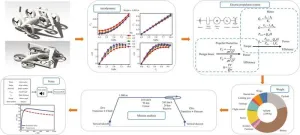(Press-News.org) The current method for assessing medication-related liver injury is not providing an accurate picture of some medications’ toxicity—or lack thereof—to the liver, according to a new study led by researchers from the Perelman School of Medicine at the University of Pennsylvania. Classification of a medication’s potential to damage the liver, termed “hepatotoxicity,” has been historically determined by counting individual reported cases of acute liver injury (ALI). Instead, the researchers used real-world health care data to measure rates of ALI within a population and uncovered that some medications’ levels of danger to the liver are being misclassified. This paper was published today in JAMA Internal Medicine.
“From a clinical standpoint, knowing the rate of severe ALI after starting a medication in real-world data will help determine which patients should be monitored more closely with liver-related laboratory tests during treatment,” said senior author Vincent Lo Re, MD, MSCE, an associate professor of Medicine and Epidemiology. “Incidence rates of severe ALI can be a valuable tool for determining a medication’s toxicity to the liver and when patients should be monitored, since incidence rates provide a truer, real-world look at this toxicity. Case reports did not accurately reflect observed rates of ALI because they do not consider the number of persons exposed to a medication, and cases of drug-induced liver injury are often underreported.”
Within the study, 17 different medications had rates that exceeded five severe ALI events per 10,000 “person-years,” a measure that reflects both the amount of people in a group and how long the study observes them (12 person-years could mean one person with data covering 12 years or two people covering six years). The team determined that 11 of these medications were in lower categories of hepatoxicity by case counts that were likely not reflective of their true risk, since their incidence rates revealed higher levels of toxicity. One of the medications that fell into this group was metronidazole, an antimicrobial that can be used to treat infections in the reproductive or gastrointestinal systems, as well as some dermatological conditions.
Incidence rates, the number of new cases of a disease within a time period divided by the number of people at risk for the disease, are a key measure for examining health in a population because they give a more complete picture than simple counting. For instance, a medication with 60 reports of liver injury would be considered the most hepatotoxic through the traditional method, using the raw number of reported liver injury cases. However, if that medication had 60 observed severe ALI events and was used by five million people, the incidence rate would be very low and likely point to the medication not being dangerous to the liver. However, if 60 severe ALI events were observed within a population of 1,000 patients, it would reflect a higher, potentially more important, rate of injury.
To determine incidence rates, Lo Re and his team, including lead author Jessie Torgersen, MD, MHS, MSCE, an assistant professor of Medicine, examined electronic medical record data on almost 8 million people provided by the United States Veterans Health Administration that had been compiled from 2000 through 2021. Each person did not have pre-existing liver or biliary disease (a condition affecting bile ducts or the gallbladder) when they began taking any of the 194 medications that were studied. Each of those medications were analyzed due to suspicion that they could cause harm to the liver, since each had more than four published reports of liver toxicity associated with their use.
On the other side of the hepatotoxicity coin, the researchers found eight medications that were classified as the most hepatotoxic based on the number of published case reports, but should actually be in the least liver-toxic group, with incidence rates of less than one severe ALI event per 10,000 person-years. For example, rates of severe ALI for statin medications, often used for high cholesterol, were in the group that had fewer than one event per 10,000 person-years.
“The systematic approach that we developed enables successful measurement of the rates of liver toxicity after starting a medication,” Lo Re said. “It wasn’t surprising that the case report counts did not accurately reflect observed rates of severe acute liver injury given the inherent limitations with case reports.”
With these findings, the researchers hope that there might soon be mechanisms established within electronic medical records to alert clinicians to closely monitor the liver-related laboratory tests of patients who start a medication with a high observed rate of severe ALI.
“Importantly, our approach offers a method to allow regulatory agencies and the pharmaceutical industry to systematically investigate reports of drug-induced ALI in large populations,” Lo Re said.
This study was funded, in part, by the National Cancer Institute (R01CA206465), National Institute on Alcohol Abuse and Alcoholism (U24AA020794, U01AA020790, U24AA022001, U01AA013566), National Institute of Diabetes and Digestive and Kidney Diseases (K08DK132977), and National Institute of Allergy and Infectious Diseases (T32AI055435).
END
New approach accurately identifies medications most toxic to the liver
2024-06-24
ELSE PRESS RELEASES FROM THIS DATE:
Study reveals new opportunities to develop cancer treatments
2024-06-24
Researchers at Baylor College of Medicine and collaborating institutions have uncovered new potential therapeutic targets for cancer and new insights into existing cancer drug targets, expanding the breadth of possibilities for treating this disease. Using a comprehensive approach that included integrating proteomics, genomics and epigenomics data from 10 cancer types, the team identified protein and small protein or peptide targets in cancer tissues and validated many of them experimentally as promising candidates for therapeutic strategies. The study appeared in Cell.
“Experience ...
Bezos Center for Sustainable Protein launches at Imperial with $30M funding
2024-06-24
Bezos Earth Fund grant establishes new Centre at Imperial to transform global food systems from environmentally damaging to innovative by creating sustainable solutions.
Imperial’s Bezos Centre for Sustainable Protein, launched today, will develop innovative and evidence-based solutions through the design, delivery, and commercialisation of alternative food products that are economically and environmentally friendly, nutritious, affordable, and tasty.
The Centre, spanning across seven Imperial academic departments, will advance research into precision fermentation, cultivated meat, bioprocessing and automation, ...
Star clusters observed within a galaxy in the early Universe for the first time
2024-06-24
The history of how stars and galaxies came to be and evolved into the present day remains among the most challenging astrophysical questions to solve yet, but new research brings us closer to understanding it.
In a new study by an international team led by Dr. Angela Adamo at Stockholm University, new insights about young galaxies during the Epoch of Reionization have been revealed. Observations with the James Webb Space Telescope (JWST) of the galaxy Cosmic Gems arc (SPT0615-JD) have confirmed that the light of the galaxy was emitted 460 million years after ...
How much oxygen do very premature babies need after birth?
2024-06-24
Giving very premature babies high concentrations of oxygen soon after birth may reduce the risk of death by 50 percent, compared to lower levels of oxygen says new research led by University of Sydney researchers.
When premature babies are born, they sometimes need help breathing because their lungs haven’t finished developing. To help babies during this process, doctors may give them extra oxygen through a breathing mask or breathing tube.
The study, published in JAMA Pediatrics, examined clinical trial data and outcomes of ...
Trial offers hope for cheaper, more tolerable, ketamine treatment
2024-06-24
For those suffering from treatment-resistant depression, the anaesthetic drug ketamine offers hope, but it has side effects and can be costly to access – a University of Otago-led clinical trial may change that.
Working in collaboration with New Zealand’s Douglas Pharmaceuticals, researchers have conducted a trial of ketamine in an extended-release tablet form.
The study, published in prestigious international journal Nature Medicine, involved 168 adults for whom regular anti-depressant therapy ...
Fertility treatments could get boost from stem cells
2024-06-24
An unexpectedly versatile and regenerative stem cell in early embryos may be key to creating new effective fertility treatments, suggests a new study in mice from the University of Copenhagen.
It probably will not surprise anyone that pregnancy is a very complicated process. First, a sperm cell must find its way and fertilize an egg in the fallopian tube, after which the egg begins to divide. After about five days, the egg becomes a blastocyst, which eventually develops into a fetus.
But for more and more people, fertility is becoming increasingly harder to achieve due to various factors ...
Ketamine slow-release tablet reduces symptoms of severe depression: Clinical trial
2024-06-24
A new tablet form of ketamine has shown promise in treating severe depression, offering a potential alternative to existing clinic-based treatments that can be expensive and lacking in convenience for some patients.
Unlike the injectable and nasal spray alternatives that require clinicians to monitor patients for two hours while side effects subside, the slow-release tablet form can be taken safely at home without medical supervision and with negligible side effects.
Led by Professor Paul Glue of University of Otago, researchers from UNSW Sydney and the affiliated Black Dog Institute (BDI) collaborated with colleagues from ...
The future takes flight: Autonomous eVTOLs transforming air mobility
2024-06-24
In recent years, a new era of transportation innovation has unfolded with the introduction of autonomous electric vertical take-off and landing (eVTOL) aircrafts. These advanced air mobility (AAM) systems are poised to revolutionize urban and regional transportation by offering efficient, sustainable, and rapid transit solutions, potentially transforming daily commutes and cargo deliveries alike.
eVTOL technology, which enables aircrafts to ascend, hover, and land vertically, has become a focus for both academic research and commercial ventures due to its numerous advantages ...
One bad apple spoils the barrel: New study uncovers multiple molecular subgroups in liver cancer with most aggressive driving clinical outcomes
2024-06-24
Singapore, 24 June 2024 – A study led by clinician-scientists and scientists from the National Cancer Centre Singapore (NCCS) and A*STAR’s Genome Institute of Singapore (GIS) and funded by the National Research Foundation Singapore (NRF) has discovered unexpected molecular heterogeneity even within the same liver tumours. More than 40% of HCC harbours more than one molecular subtype within the same tumour and in these, the clinical outcomes for the patients are best predicted by the most aggressive subtype. This phenomenon, termed the “bad apple effect”, has significant implications on the understanding of liver cancer and suggests that a more holistic sampling ...
Rising health care prices are driving unemployment and job losses
2024-06-24
New Haven, Conn. — Rising health care prices in the U.S. are leading employers outside the health care sector to reduce their payroll and decrease their number of employees, according to a new study co-authored by Yale economist Zack Cooper.
The study, published June 24 as a working paper by the National Bureau of Economic Research (NBER), found that when health care prices increased, non-health care employers responded by reducing their payroll and cutting the jobs of middle-class workers. For the average county, a 1% increase in health ...


